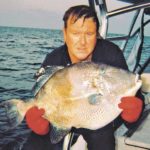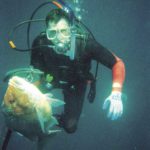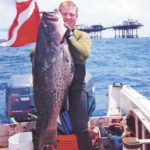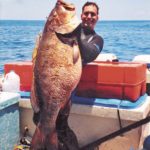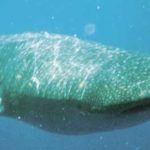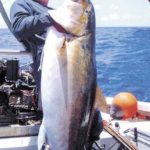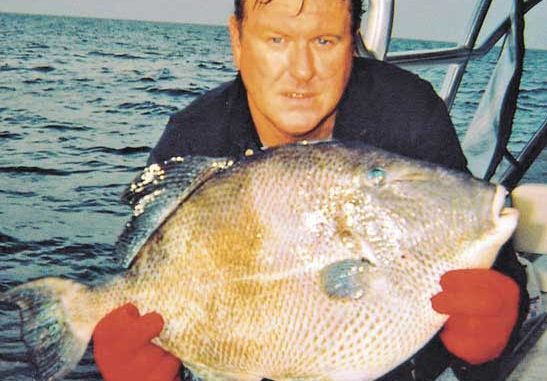
Oil rigs are bad for the environment, right? Then why is there such a variety of fish swimming in such massive schools around their legs?
During his exile in Michigan, our old Tigerland chum Eddie Fleeks chummed up with some of the locals who showed him the ropes of the local deer-hunting. Not that there was much to teach. “It was like shooting nutria down here,” Eddie snorts. “A complete joke. Saw more deer up there in one day than I see down here in a season.”
Clark Erickson became his hunting buddy up there. Now, on Clark’s visit to New Orleans, Eddie insisted on returning the favor by introducing him to our summer hunting, the one under the rigs. Clark’s wife Tracy could not be dissuaded from going.
“Oh, I love scuba diving!” she chirped. “Clark and I go to Belize every year. We have a great time!”
“This is a little different,” Eddie tried to explain to both Clark and Tracy during a dinner of grilled triggerfish at Doc’s Venice houseboat.
But these worldly divers merely scoffed.
“I even used a pole spear in the Keys once,” smiled Tracy. “So don’t worry.”
Pelayo smiled, looked around and re-filled the wine glass she held out.
The following morning found us gazing expectantly into the dark green water at West Delta 40 from Pelayo’s 21-footer.
“Look at all the FISH!” Clark gasped. “What are those?”
“Mainly spadefish and sheepshead near the surface.” Pelayo quipped.
The water was gorgeous and the Gulf flat, something we notice most often in August, generally speaking our slowest month for fishing — hence our penchant for a semi-substitute. We couldn’t suit up fast enough.
Soon we were slowly descending through the (fortunately) still and clear waters surrounding the rig. We finned through clouds of spadefish and sheepshead while descending. A wall of wild-eyed bluefish roared by. Another of hardtails rushed in right behind them. Tracy’s head spun from side to side trying to register a panorama unmatched even by the Caribbean’s most exotic dive-sites. I looked inside her mask, and saw her eyes bulging. Was it awe or fright — or both?
From the surface, they never dreamt it looked like this. That paint and rust above turned into a kaleidoscope of colors below — sponges, urchins, anemones, barnacles, coral. From close-up, you see the brightest colors in miniature. Tiny blenneys poke their heads from vacant barnacles. Gobies in red and blue dart around the barnacles. Damselfish, like miniature LSU fans, half in purple, half in gold, flash and flutter around the beam.
But these aren’t the ones we brought the spearguns for.
To my right, a solid wall of bluefish roars by again, scattering the spadefish in their path. The schools of spadefish are so thick, they actually have to part to let me through. Sheepshead mill around every piling and beam. They fin along lazily, unconcerned by the 20-pound jack crevalle swimming a few yards away or Pelayo’s bubbles streaming past them.
Three triggerish tail behind me waiting for a snack. Triggerfish love to follow divers around pouncing on whatever we spear to nip at the shreds, even when it’s one of them. Sometimes they miss and grab a finger or earlobe. Sometimes they grab a human appendage deliberately. Sharks and barracudas are chumps compared to triggerfish.
Marine biologists note that artificial reefs generally support more fish than natural reefs. One rig-dive will confirm this. And most of these fish — from hardtails to triggerfish to mangroves — were on the UPcurrent side of the rig, a pattern we’ve always noticed.
We chose to take our guests in August for a reason. River levels are lowest in August and the Gulf clearest, even close in. We’ve found crystal-blue water among the West Delta 30s and Bay Marchand rigs in August, at barely 50-foot depths. We also chose a weekend with little tidal range. This means less current. The worst days for fishing are generally the best for diving.
These conditions make for a relaxing, enjoyable dive, a must for beginners to the rigs. These shallow rigs hold masses of mangroves, triggerfish, lookdowns and occasional cobia and pompano. In fact, cobia show up at these rigs in the greatest numbers in late summer and early fall. And the swarms of sheepshead and spadefish provide easy pickings for anyone with a pole spear, even snorkelers. These fish swarm around our rigs even in the middle of the notorious “Dead Zone” season, where portions of the upper Gulf contain scant sea-life.
Suddenly, Clark jerked back, and a cloud of bubbles escaped from his regulator. Tracy started pointing urgently below her with the pole spear while clutching her husband with her free hand. They looked at me with bulging eyes and, yes — no mistaking the look now — stark terror.
A cobia was sauntering toward us from below. It’s easy to mistake them for sharks. I nodded and waved my hand trying to indicate that all was cool, and they seemed to understand. Suddenly, Pelayo appeared from behind a beam right under us, his speargun extending toward the fish.
Finally, the “schlink” sounded, and I saw the shaft glance off the big cobia.
“NO!” I thought, and quickly cocked my magnum band and gave chase but to no avail. Cobia are known as oftentimes “stupid” with divers — but not one that’s already felt a scratch from a speargun shaft.
Then I looked behind and saw Tracy nail a mangrove squarely through the spine with her pole spear, while Glenn aimed at a sheepshead. These people catch on quick, I thought. However different their normal hunting up north, the instinct for the chase was the same as ours. Their experience with Caribbean dives just made the catching on that much easier.
I already had my eye on some triggerfish hovering around and nipping at Tracy’s mangrove. Better get over there and give her a hand, I thought. They were getting too close for comfort. Hope she doesn’t mistake them for those cute sergeant majors and angelfish she feeds on caribbean dives. Those won’t take a chunk from your finger or earlobe.
I swam over, quickly skewered two of the chunky trigs and slid them down the shaft onto the cable as a makeshift stringer for the moment. Looking down, I noticed Pelayo’s bubbles streaming up from the murky depths. Focusing, I saw Pelayo closing on what looked like a huge school of red snapper (pinkish white down here) around a corner beam, and I recalled what Terry “Mr. Helldiver” Miguad had been telling me about his recent dives, even at fairly shallow rigs.
“Wall to wall red snapper, Hom-Boy-Da,” he’d been stressing. “In East Bay, huge schools of small snapper were actually following me around. In over 30 years of diving, I’d never seen anything like that. All of us are seeing more snapper than we’ve seen in years. It’s unreal!
“There were rumors that the Gulf Council, when it came up with its recent findings that lowered the snapper limit, was completely ignoring the red snapper around oil platforms in their count. It seemed crazy, and the issue is disputed by many parties. But I tell ya Hom-Boy-Da, considering how many snapper we’ve all been seeing lately, I wouldn’t doubt it.”
Tracy, Clark and I ended up prowling near the surface for the rest of the morning, while Pelayo plunged a bit deeper for red snapper and grouper (but not much deeper — the red snapper were hanging out around 50-foot depths).
Clark and Tracy’s tanks lasted them over an hour this way, and with the beautiful water and abundant mangroves, they saw no reason to hit the depths. We closed out with a nice bag (not quite limits) of mangroves, along with a mess of triggerfish, sheepshead and spadefish, in descending order.
A version of this bag is also possible while line fishing with medium tackle. But mangroves are slick. They hit cut bait or jigs — but not regularly. Only by chumming will you get a mess of them worked up and ravenous enough to hit shrimp or squid. And this bait has to completely cover and hide the hook.
To catch mangroves consistently, use live bait — shrimp, pogies or live small crabs. (We’ve speared mangroves at the shallow rigs off Fourchon whose stomachs were crammed with 2-inch crabs.) Use light line, and dispense with a leader or even a swivel when fishing for these snapper — not because they’ll grab it and cut the line like the blues and Spanish but because they’ll see it and snub the offering. Mangroves inhabit all rigs from 30-foot depths out to 100. They’re usually near the surface to 30 feet down. A cork sometimes helps to keep the bait in their range.
Triggerfish also inhabit the mid-depths. Use a small (1/0, 2/0) hook and small piece of cut fish (blue or hardtail) for these. Squid or shrimp they’ll steal too efficiently.
In sum: The fish that inhabit the mid-depths in the shallower rigs in summer provide sport and dining to rival anything on the bottom farther offshore. Give them a try, especially in the “Dead Zone.”
Clark and Tracy would be taking fish back to Michigan with them on dry ice, and they fell in love with rig diving.
“My goodness,” Gasped Tracy. “I saw more fish than during an entire week’s diving off Cozumel or the Florida Keys!”
When gas prices skyrocketed and offshore drilling became a hot issue, Clark (and even Tracy) became evangelists for the “Drill Here! Drill Now! Pay Less!” campaign back home in Flint (Michael Moore’s hometown, no less!). They much prefer evidence over environmental hysteria. And having seen this evidence with their own eyes on rig dives, they couldn’t contain themselves from offering their two cents-worth whenever the issue arose.
Louisiana’s coastal waters contain 3,200 of the roughly 3,700 offshore production platforms in the Gulf of Mexico. From these, Louisiana also produces 25 percent of America’s domestic oil, and no major oil spill has ever soiled its coast, even with the most destructive hurricanes in America’s history battering the production network. Unreal. So for those interested in evidence over hysterics, by simply looking bayou-ward, a lesson in the “environmental perils” of offshore oil drilling presents itself very clearly.
And here’s the craziest part: Fashionable Florida, which zealously prohibits offshore oil drilling, had its gorgeous “Emerald Coast” panhandle beaches soiled by an ugly oil spill in 1976. This spill, as almost all oil spills, resulted from the transportation of oil — not from the extraction of oil.
Assuming those such as Hugo Chavez deign to keep selling us oil, we’ll need increasingly more and we’ll need to keep transporting it stateside — typically to refineries in Louisiana and Texas.
This path takes those tankers (as the one in 1976) smack in front of Florida’s panhandle beaches.
Recall the Valdez, the Cadiz, the Argo Merchant. These were all tanker spills. The production of oil is relatively clean and safe. Again, it’s the transportation that presents the greatest risk. And even these spills (though hyped hysterically as environmental catastrophes) always play out as minor blips, those pictures of oil-soaked seagulls notwithstanding.
To the horror and anguish of professional greenies, Alaska’s Prince William Sound recovered completely. More birds get fried by landing on power lines and smashed to pulp against picture windows in one week than perished from three decades of oil spills.
An environmental study (by apparently open-minded scientists) revealed that urban runoff and treated sewage dump 12 times the amount of petroleum into the Gulf as those thousands of oil-production platforms. And oil seeping naturally through the ocean floor into the Gulf, where it dissipates over time, accounts for seven times the amount spilled by rigs and pipelines in any given year.
Also fascinating is a study of the relative health of coral reefs in oil-production areas versus “protected areas.” The Flower Garden coral reefs lie off the Louisiana-Texas border. Unlike any of the Florida Keys reefs, they’re surrounded by dozens of offshore oil platforms. These have been pumping away for the past 50 years.
Yet according to G.P. Schmahl, a federal biologist who worked for decades in both places, “The Flower Gardens are much healthier, more pristine than anything in the Florida Keys. It was a surprise to me. And I think it’s a surprise to most people.”
“A key measure of the health of a reef is the amount of area taken up by coral,” according to a report by Steve Gittings, the National Oceanic and Atmospheric Administration’s science coordinator for marine sanctuaries. “Louisiana’s Flower Garden boasts nearly 50 percent coral cover. In the Florida Keys, it can run as little as 5 percent.”
Mark Ferrulo, a Florida “environmental activist,” uses the very example of Louisiana for his anti-offshore drilling campaign, calling Louisiana’s coast “the nation’s toilet.” Florida’s fishing fleet must love fishing in toilets, and her restaurants serving what’s in them. Most of the red snapper you eat in Florida restaurants are caught around Louisiana’s oil platforms.
